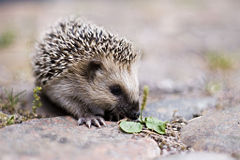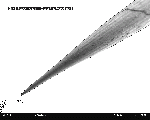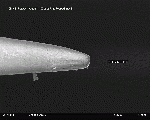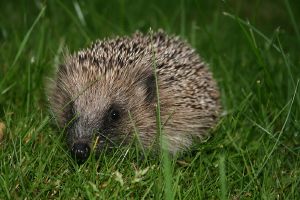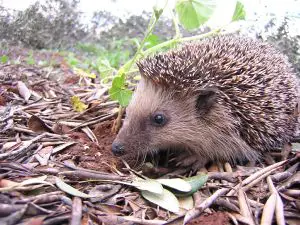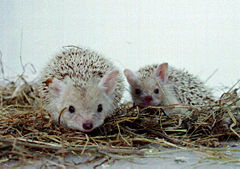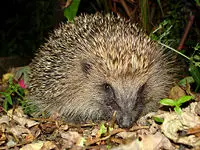Hedgehog
| Hedgehogs[1] | ||||||||||||
|---|---|---|---|---|---|---|---|---|---|---|---|---|
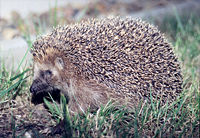 European Hedgehog
| ||||||||||||
| Scientific classification | ||||||||||||
| ||||||||||||
|
Hedgehog is the common name for any of the small spiny, mammals comprising the subfamily Erinaceinae of the Erinaceidae family, characterized by rounded bodies, short and barbless spines on their backs and sides, often very short or rudimentary tails, and the behavior of rolling into a tight ball when frightened. However, the name hedgehog often is applied more broadly to any of the members of the family Erinaceidae, which includes a second extant subfamily, Galericinae, whose spineless, long-tailed members generally are known as gymnures, or moonrats, but also as hairy hedgehogs. This article will be limited to the true hedgehogs of the Erinaceinae subfamily, whose members also are differentiated with the name spiny hedgehogs.
There are sixteen extant species of spiny hedgehog in five genera, found through parts of Europe, Asia, Africa, and New Zealand. There are no hedgehogs native to Australia, and no living species native to North America; those in New Zealand are introduced. Hedgehogs have changed little over the last 15 million years. They have adapted to a largely nocturnal, insectivorous way of life.
Hedgehogs provide a number of values for humans, including pest control (consuming a lot of insects that invade gardens) and serving for food in some cultures, and many are raised as pets. Ecologically, they play an important role in food chains, consuming a wide variety of invertebrates and small vertebrates as well as plant matter and being consumed by some predators, including birds, ferrets, foxes, and so forth.
Overview: Erinaceidae
Erinaceidae is the only living family in the order of the Erinaceomorpha. It contains two subfamilies: The well-known hedgehogs of the subfamily Erinaceinae and the gymnures, or moonrats, of the subfamily Galericinae.
Erinaceids are generally shrew-like in form, with long snouts, and short tails. They are, however, much larger than shrews, ranging from 10 to 15 centimeters in body length and 40 to 60 grams in weight in the case of the short-tailed gymnure, up to 26 to 45 centimeters and 1 to 1.4 kilograms in the greater moonrat. They typically have five toes in their front feet, in some cases with strong claws for digging, and they have large eyes and ears. Hedgehogs possess hair modified into sharp spines to form a protective covering over the upper body and flanks, while gymnures have only normal hair. All species have anal scent glands, but these are far better developed in gymnures, which can have a powerful odor (Wroot 1984).
Erinaceids are omnivorous, with the major part of their diet consisting of insects, earthworms, and other small invertebrates. They also eat seeds and fruit, and occasionally bird's eggs, along with any carrion they come across. Their teeth are sharp and suited for impaling invertebrate prey. The dental formula for erinaceids is:
| 2-3.1.4-4.3 |
| 3.1.2-4.3 |
The name "hedgehog" came into use around the year 1450, derived from the Middle English heyghoge, from heyg, hegge, meaning "hedge," because it frequents hedgerows, and hoge, hogge, meaning "hog," from its pig-like snout (OED 2007). Other folk names include "urchin," "hedgepig," and "furze-pig."
Description
Physical description
Hedgehogs are easily recognized by their spines, which are hollow hairs made stiff with keratin. Their spines are not poisonous or barbed and, unlike the quills of a porcupine, cannot easily be removed from the animal. However, spines normally come out when a hedgehog sheds baby spines and replaces them with adult spines. This is called "quilling." When under extreme stress or during sickness, a hedgehog can also lose spines.
Hedgehogs have five toes on their front paws with short nails. However, on their back paws, they have four toes with long, constantly growing nails. They have these characteristics because hedgehogs burrow.
Similar to opossums, mice, and moles, hedgehogs have some natural immunity against snake venom because the protein erinacin is present in the animal's muscular system (Omori-Satoh et al. 2000).
Behavior
All hedgehogs are primarily nocturnal, although different species can be more or less likely to come out in the daytime. The hedgehog sleeps for a large portion of the daytime either under cover of bush, grass, rock, or in a hole in the ground. Again, different species can have slightly different habits, but in general hedgehogs dig out dens for shelter. All wild hedgehogs can hibernate, although not all do; hibernation depends on temperature, species, and abundance of food.
A defense that all species of hedgehogs possess is the ability to roll into a tight ball, causing all of the spines to point outwards. However, its effectiveness depends on the number of spines, and since some of the desert hedgehogs are adapted to carry less weight, they are much more likely to try to run away and sometimes even attack the intruder, trying to ram into the intruder with its spines, leaving rolling as a last resort. This results in a different number of predators for different species: While forest hedgehogs have relatively few, primarily birds (especially owls) and ferrets, smaller species like the long-eared hedgehog are preyed on by foxes, wolves, and mongooses.
Hedgehogs are fairly vocal, and communicate not only in a series of grunts and snuffles, but sometimes in loud squeals (depending on species).
Hedgehogs occasionally perform a ritual called anointing. When the animal comes across a new scent, it will lick and bite the source and then form a scented froth in its mouth and paste it on its spines with its tongue. It is not known what the specific purpose of this ritual is, but some experts believe anointing camouflages the hedgehog with the new scent of the area and provides a possible poison or source of infection to any predator that gets poked by their spines. Anointing is sometimes also called anting because of a similar behavior in birds.
Hedgehogs perform well with other pets, including cats and dogs. They are occasionally threatened by these animals, though, but for those rare instances, the hedgehogs just roll into a ball until the threat is gone.
Diet
Although forest hedgehogs, most well-known to Europeans, are mainly insectivores (a dietary category that applies to any organism feeding chiefly on insects and similar small creatures), this is not necessarily true for other species. Most hedgehogs are almost omnivorous. Hedgehogs feed on insects, snails, frogs and toads, snakes, bird eggs, carrion, mushrooms, grass, roots, berries, melons, and watermelons. In fact, berries constitute a major part of an Afghan hedgehog's diet in early spring after hibernation. The hedgehog is occasionally spotted after a rainstorm foraging for earthworms.
In areas that have hedgehogs in the wild, they are often welcomed as a natural form of garden pest control. Many people leave food out to attract hedgehogs.
Reproduction and lifespan
Depending on the species, the gestation period of hedgehogs is from 35 to 58 days. The average litter is 3 to 4 newborns for larger species and 5 to 6 for smaller ones. As with many animals, it is not unusual for an adult male hedgehog to kill newborn males.
The hedgehog's dilemma is based upon the apparent danger of a male hedgehog being injured from a spine while mating with a female hedgehog. The hedgehog's dilemma is an analogy about the challenges of human intimacy. It describes a situation in which a group of hedgehogs all seek to become close to one another in order to share their heat during cold weather. However, once accomplished, they cannot avoid hurting one another with their sharp quills. It is an analogy that the closer two people are to each other, the more they may hurt one another. However, this is not an issue for hedgehogs, as the male's penis is very near the center of its abdomen (often mistaken for a belly button) and the female has the ability to curl her tail upward to the point that her vulva protrudes behind the rest of her body. As such, the male does not have to get completely on top of the female when mating.
Hedgehogs have a relatively long lifespan for their size. Larger species of hedgehogs live 4 to 7 years in the wild (some have been recorded up to 16 years), and smaller species live 2 to 4 years (4 to 7 years in captivity), compared to a mouse at 2 years and a large rat at 3 to 5 years. Lack of predators and controlled diet contribute to a longer lifespan in captivity.
Hedgehogs are born blind. Many believe that they are born without quills, which develop in the following days. However, the quills are easily visible within hours of birth, after the newborn hedgehog has been cleaned. Quills are very long and visible.
Hedgehogs and humans
Hedgehogs have provided important values to human beings, including in pest control, as a source of food, and as pets.
Hedgehogs are a food source in many cultures. Hedgehogs were eaten in Ancient Egypt and some recipes of the Late Middle Ages call for hedgehog meat (Pidd 2007). Hedgehog meat is still acceptable in some societies, and there are folk-remedies that include it as an ingredient.
However, the greatest risk to hedgehogs today may be from cars and pesticides. As with most small mammals living around humans, cars pose a great threat to hedgehogs. Many are run over as they attempt to cross roadways. Another common human-related cause of fatality is pesticides. Hedgehogs that eat insects filled with pesticides will often form digestive problems and eventually die.
In 2006, McDonald's changed the design of their McFlurry containers to be more hedgehog-friendly (Ratcliffe 2006). Previously, hedgehogs would get their heads stuck in the container as they tried to lick the remaining food from inside the cup. Then, being unable to get out, they would starve to death. Domesticated hedgehogs display this behavior by getting their head stuck in tubes (commonly, lavatory paper tubes) and walking around with the tube on their head. Hedgehog owners often refer to this as "tubing" and promote the behavior by supplying clean tubes (Loane).
Pest control
Hedgehogs are a powerful form of pest control. A single hedgehog can keep an average garden free of pests by eating up to 200 grams of insects each night. It is common throughout the United Kingdom to see people attempting to lure hedgehogs into their gardens with treats and hedgehog-sized holes in their fences.
One problem with using hedgehogs for garden pest control is the use of chemical insecticide. While the hedgehog is large enough to resist most insecticides, it cannot withstand them if it eats many insects that have become full of the poison. This causes many hedgehog deaths where pet hedgehogs eat contaminated bugs within the house.
In areas where hedgehogs have been introduced, such as New Zealand and the islands of Scotland, the hedgehog itself has become a pest. In New Zealand, it causes immense damage to native species including insects, snails, and ground-nesting birds, particularly shore birds. As with many introduced animals, it lacks natural predators. With overpopulation, it kills off more insects than initially intended and expands its diet to include things such as snails, worms, and the eggs of wading birds. Attempts to eliminate hedgehogs from bird colonies on the Scottish islands of North Uist and Benbecula in the Outer Hebrides have met with considerable opposition.
Domesticated hedgehogs
Common hedgehog pets are hybrids of the white-bellied hedgehog or four-toed hedgehog (Atelerix albiventris) and the North African hedgehog (A. algirus). This hybrid is smaller than the West European hedgehog, and thus is sometimes called the African pygmy hedgehog. Other common pets are the long-eared hedgehog (Hemiechinus auritus) and the Indian long-eared hedgehog (H. collaris).
Domesticated species prefer a warm climate (above 72°F/22°C but below 85°F/29.5°C) and do not naturally hibernate. They diet is mainly an insectivorous one. Commonly, this is replaced with cat food and ferret food and is supplemented by insects and other small animals. Today, many pet stores sell hedgehog mixes that are specifically formulated for hedgehogs. Crickets, mealworms, and pinkies (baby mice) are also favored treats. It is illegal to own a hedgehog as a pet in some U.S. states and some Canadian municipalities, and breeding licenses are required. No such restrictions exist in most European countries with the exception of Scandinavia.
The purchase of domesticated hedgehogs has seen a considerable increase in the last few years owing to their apparently innocent and playful looks. Hedgehogs are difficult to maintain as pets, however, because of their low resistance to climate and temperature changes, and their inability to adapt to enclosed environments.
Hedgehog diseases
Humans share many diseases common to hedgehogs (WIN 2008). These include cancer, fatty liver disease, and cardiovascular disease.
Cancer is very common in hedgehogs. The most common is squamous cell carcinoma. Squamous cell spreads quickly from the bone to the organs in hedgehogs, unlike in humans. Surgery to remove the tumors is rare because it would result in removing too much bone structure.
Fatty liver disease is believed by many to be caused by bad diet. Hedgehogs will eagerly eat foods that are high in fat and sugar. Having a metabolism adapted for low-fat, protein-rich insects, this leads to common problems of obesity. Fatty liver disease is one sign, heart disease is another.
Hedgehogs uncommonly transmit a characteristic fungal skin infection to human handlers as well as other hedgehogs. This ringworm or dermatophytosis infection is caused by Trichophyton erinacei, which forms a distinct mating group within the Arthroderma benhamiae species complex (Takahashi et al. 2003).
Genera and species
Subfamily Erinaceinae (Hedgehogs or spiny hedgehogs)[1]
- Genus Atelerix
- Four-toed Hedgehog, Atelerix albiventris
- North African Hedgehog, Atelerix algirus
- Southern African Hedgehog, Atelerix frontalis
- Somalid Hedgehog, Atelerix sclateri
- Genus Erinaceus
- Amur Hedgehog, Erinaceus amurensis
- Southern White-breasted Hedgehog, Erinaceus concolor
- West European Hedgehog, Erinaceus europaeus
- Northern White-breasted Hedgehog, Erinaceus roumanicus
- Genus Hemiechinus
- Long-eared Hedgehog, Hemiechinus auritus
- Indian Long-eared Hedgehog, Hemiechinus collaris
- Genus Mesechinus
- Daurian Hedgehog, Mesechinus dauuricus
- Hugh's Hedgehog, Mesechinus hughi
- Genus Paraechinus
- Desert Hedgehog, Paraechinus aethiopicus
- Brandt's Hedgehog, Paraechinus hypomelas
- Indian Hedgehog, Paraechinus micropus
- Bare-bellied Hedgehog, Paraechinus nudiventris
Subfamily Galericinae (Gymnures, moonrates, or hairy hedgehogs)[1]
- Genus Echinosorex
- Echinosorex gymnura (Greater Moonrat)
- Genus Hylomys
- Hylomys megalotis (Large-eared Gymnure)
- Hylomys parvus (Dwarf Gymnure)
- Hylomys suillus (Lesser Gymnure)
- Genus Neohylomys
- Neohylomys hainanensis (Hainan Gymnure)
- Genus Neotetracus
- Neotetracus sinensis (Shrew Gymnure)
- Genus Podogymnura
- Podogymnura aureospinula (Dinagat Gymnure)
- Podogymnura truei (Mindanao Gymnure)
Notes
- ↑ 1.0 1.1 1.2 R. Hutterer, Subfamily Erinaceinae, Pages 212–217 in D. E. Wilson and D. M. Reeder, eds., Mammal Species of the World, 3rd edition (Johns Hopkins University Press, 2005). ISBN 0801882214.
ReferencesISBN links support NWE through referral fees
- Hutterer, R. 2005. Subfamily Erinaceinae. In D.E. Wilson and D.M. Reeder (eds.), Mammal Species of the World, 3rd edition. Johns Hopkins University Press. ISBN 0801882214.
- Integrated Taxonomic Information System (ITIS). 2006a. Erinaceinae G. Fischer, 1814. ITIS Taxonomic Serial No.: 633423. Retrieved August 10, 2008.
- Integrated Taxonomic Information System (ITIS). 2006b. Erinaceidae G. Fischer, 1814. ITIS Taxonomic Serial No.: 552310. Retrieved August 10, 2008.
- Loane, B. n.d. Environmental enrichment. Hedgehog World. Retrieved August 11, 2008.
- Omori-Satoh, T., Y. Yamakawa, and D. Mebs. 2000. The antihemorrhagic factor, erinacin, from the European hedgehog (Erinaceus europaeus), a metalloprotease inhibitor of large molecular size possessing ficolin/opsonin P35 lectin domains. Toxicon 38(11): 1561-1580. Retrieved August 11, 2008.
- Oxford English Dictionary. 2007. Oxford University Press. Retrieved July 13, 2007.
- Pidd, H. 2007. Roast hedgehog and nettle pud: A slap-up feast for ancient Britons. The Guardian September 14, 2007. Retrieved August 11, 2008.
- Radcliffe, I. 2006. A prickly problem solved as hedgehog hazard is spiked. News.scotsman August 23, 2006. Retrieved August 11, 2008.
- Takahashi, Y., A. Sano, K. Takizawa, K. Fukushima, M. Miyaji, and K. Nishimura. 2003. The epidemiology and mating behavior of Arthroderma benhamiae var. erinacei in household four-toed hedgehogs (Atelerix albiventris) in Japan. Nippon Ishinkin Gakkai Zasshi 44(1): 31–8.
- Wildlife Information Network (WIN). 2008. List of hedgehog diseases. Wildlife Information Network. Retrieved August 11, 2008.
- Wroot, A. 1984. Hedgehogs. In D. Macdonald, The Encyclopedia of Mammals. New York: Facts on File. ISBN 0871968711.
Credits
New World Encyclopedia writers and editors rewrote and completed the Wikipedia article in accordance with New World Encyclopedia standards. This article abides by terms of the Creative Commons CC-by-sa 3.0 License (CC-by-sa), which may be used and disseminated with proper attribution. Credit is due under the terms of this license that can reference both the New World Encyclopedia contributors and the selfless volunteer contributors of the Wikimedia Foundation. To cite this article click here for a list of acceptable citing formats.The history of earlier contributions by wikipedians is accessible to researchers here:
The history of this article since it was imported to New World Encyclopedia:
Note: Some restrictions may apply to use of individual images which are separately licensed.
